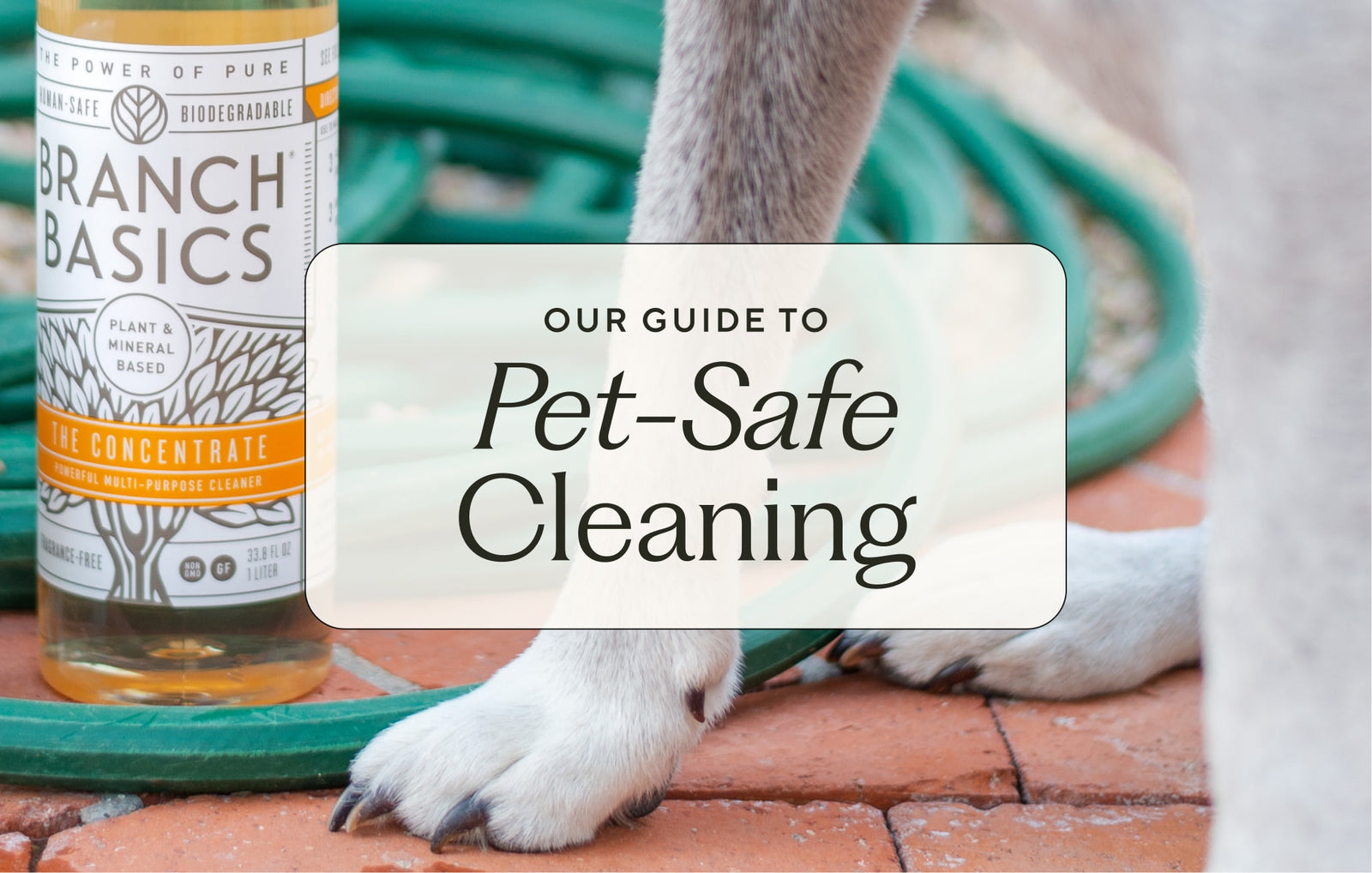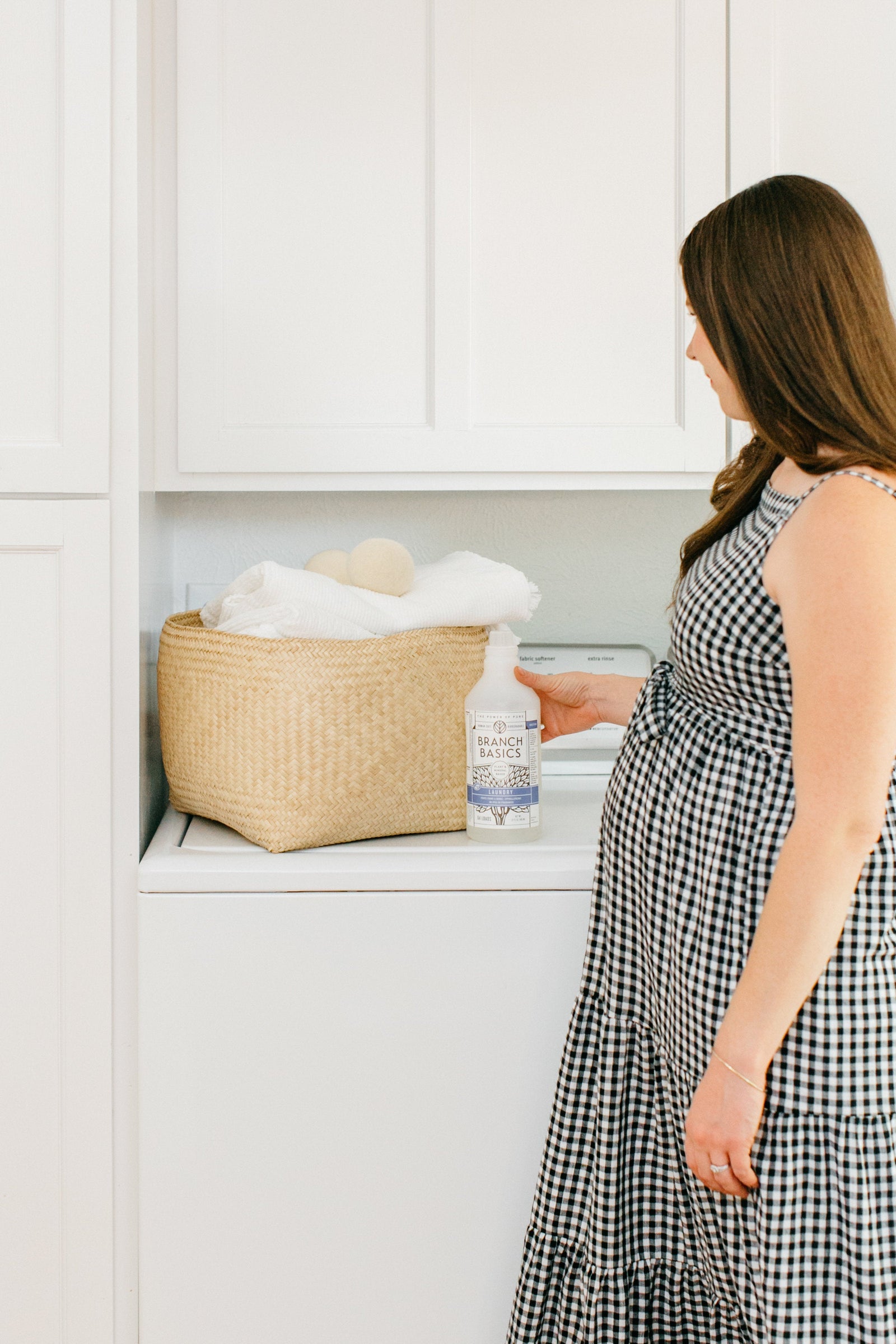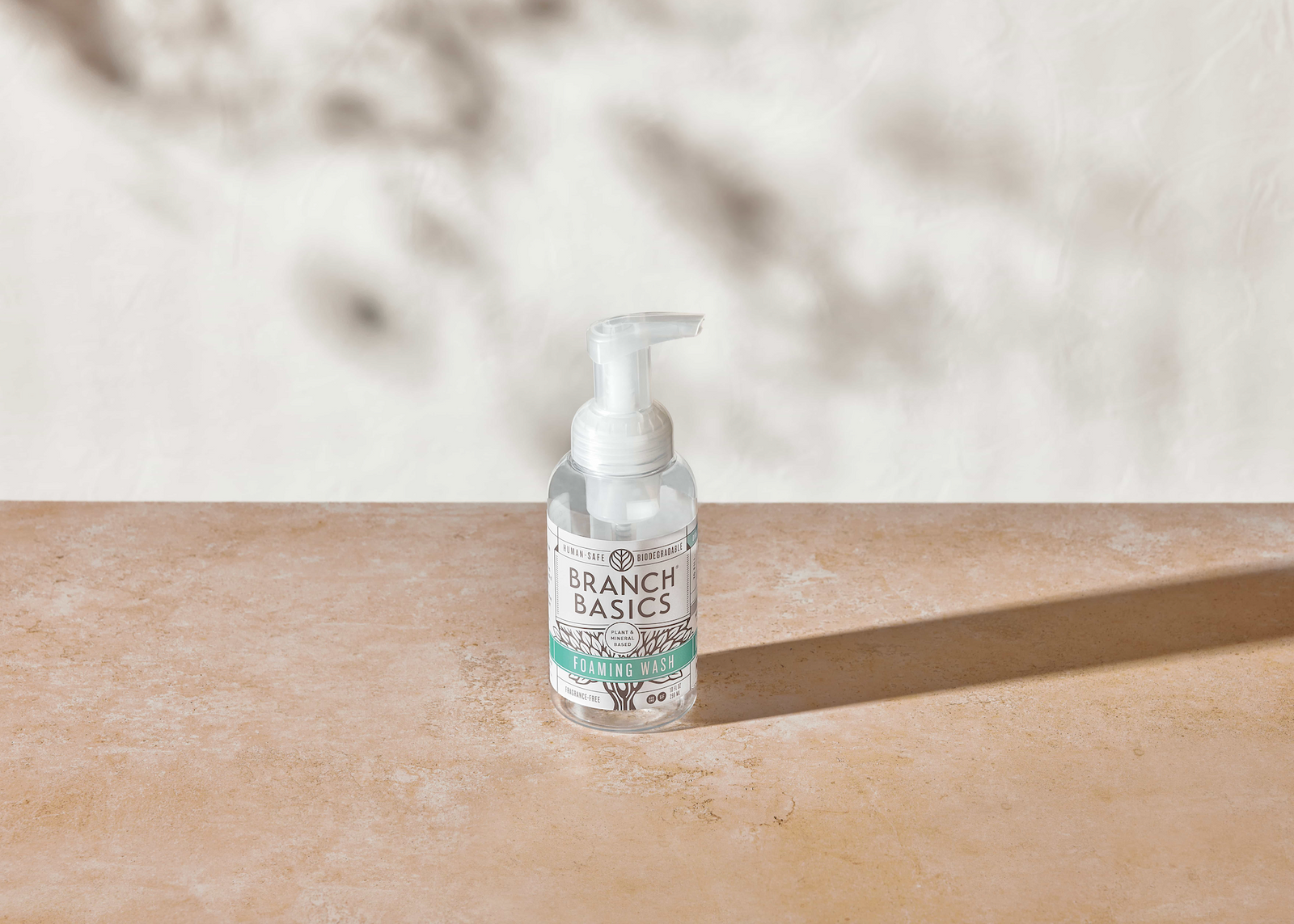Our Guide To Pet-Safe Cleaning Products

If you love pets of all shapes and sizes (like we do!), then you know how important it is to keep them safe and healthy.
Sadly, thousands of pets are poisoned every year by ingesting, inhaling, or coming into contact with common household cleaning and laundry products. And the smaller the pet, the more susceptible they are to chemical poisoning.
This leaves pet owners with two options: become familiar with every chemical that could injure your pet and keep them under lock and key, or replace synthetic chemical products and pesticides with safe alternatives.
In today’s article, we’ll cover which cleaning products are unsafe for pets, safe DIY cleaners and alternatives, how to use Branch Basics for everything pet-related, and how to minimize the risk when cleaning.
Ingredients To Avoid

Despite the fact conventional cleaners are marketed as “safe”, the vast majority contain chemical ingredients that can be harmful or even deadly to pets. Some of the most common ingredients to watch out for include:
Ammonia
Straight ammonia has largely gone out of fashion as a cleaner. However, it is still used in commercial cleaning products, such as window cleaner.
Its strong fumes are respiratory irritants and can cause acute and chronic lung damage in dogs, cats, humans, and other pets. If swallowed, it can cause serious damage to the mouth, throat, and gastrointestinal tract. It can also cause permanent damage if it comes into contact with the eyes.
Chlorine Bleach
Bleach is an EPA-registered pesticide that can be deadly to pets (and humans) if ingested, absorbed into the skin, or inhaled. It’s a skin, eye and throat irritant that can damage the mucous membranes and respiratory system.
Bleach can also become a deadly gas when mixed with ammonia, vinegar, drain cleaners, alcohol, hydrogen peroxide, dirty water high in organic matter and other household cleaning products.
Bleach-containing toilet bowl cleaner, for example, can be a big problem for dogs (or cats) who drink out of the toilet. And smaller pets, like birds, can be killed or seriously injured by inhaling bleach fumes.
Essential Oils
Yes, you read right. Even 100% natural essential oils found in cleaning products can be harmful or irritating to dogs and cats.
Per the American Kennel Club, the following essential oils are poisonous to dogs when ingested or applied topically:
- Cinnamon
- Citrus
- Pennyroyal
- Peppermint
- Pine
- Sweet birch
- Tea tree (melaleuca)
- Wintergreen
- Ylang Ylang
Cats are even more sensitive, because they lack an essential liver enzyme required to break down essential oils. Per the Pet Poison Hotline: “Cats are also very sensitive to phenols and phenolic compounds, which can be found in some essential oils. The higher the concentration of the essential oil (i.e. 100%), the greater the risk to the cat.”
Essential oils known to cause poisoning in cats include:
- Cinnamon
- Clove oil
- Eucalyptus
- Pennyroyal
- Pine
- Peppermint
- Sweet birch
- Tea tree (melaleuca)
- Wintergreen
- Ylang Ylang
This is especially important to be aware of if you use any type of scented products, including natural products which are typically fragranced with essential oils. Also, if you DIY your own cleaners, be sure to skip the essential oils.
Formaldehyde
Formaldehyde is highly toxic. It is a lung, skin, eye, nose, and throat irritant and studies report increased incidence of nasal squamous cell cancer in animals. However, it’s a tricky one to spot on labels because it’s often produced as a by-product from other chemicals or chemical combinations.
We discuss this at length in: 23 Sources Of Formaldehyde To Remove From Your Home. But when it comes to cleaning, there are 3 main sources to watch out for:
- Fragrance including plug-ins, air freshener, and fragranced cleaning and laundry products.
-
Essential oils and cleaning products containing terpenes. These can react with ozone in the air and create formaldehyde and other particulates in your home.
4 - The main essential oils to watch out for are those containing d-limonene, pinene, and citrus.
- This may not be an issue if your local air does not contain high levels of ozone (and if you’re using an ozonator or air purifier with ozone in your house, we’d encourage you to stop now!). However, in certain areas of California, for example, ozone degrading air quality is a concern. You can check the ozone levels in your area by visiting: AirNow.
Fragrance
Fragrance has been called “the new second-hand smoke” and is one of the world’s top allergens. That’s because just one patented fragrance found in a floor cleaner or laundry detergent, for example, could contain hundreds of harmful synthetic chemicals. All nestled under the label: “fragrance”.
We’ve done several deep dives into the proven human health perils of fragrance in Fragrance Is The New Secondhand Smoke and Stop Using The F Word. But one of the worst things about them is how they act as endocrine/hormone disruptors, can damage the kidneys, central nervous system, and liver, can cause cancer in animals, and irritate or damage the entire respiratory system. Although we can’t seem to convince our regulators that fragranced products should at least contain a warning label for human use, the experts all seem to agree that they’re bad news for pets.
Formaldehyde is part of the problem, as are other volatile organic compounds (commonly known as VOCs). These aromatic chemicals are ubiquitous in cleaning and laundry products, and produce harmful gasses that can cause a variety of ill effects in pets (and humans!).
To give you an idea of just how insidious these toxins are, a study published in the Environmental Impact Assessment Review, found 133 different VOCs emitted from the 25 different air fresheners and cleaning products, with an average of 17 VOCs per product. Of the 133 VOCs, 24 are classified as toxic or hazardous under U.S. federal laws, and each product emitted at least one of these compounds.
Ready for another shocker? The VOC impact of the “green” products tested in the same study were not significantly different from the other products. Hopefully, in many cases, the company is innocent of intentional deception, as sourcing and processing issues with ingredients are sometimes unknown. However, this is a prime example of how green-washing is deceiving well-meaning consumers and negatively impacting our health.
Glycol Ethers
These include ingredients such as propylene glycol, ethylene glycol, and diethylene glycol. Glycol ethers act as solvents, which dissolve grease and grime but are very poisonous to pets. Dogs especially can be attracted to the naturally sweet taste of ethylene glycol. Consumption of even small amounts can result in damage to the liver and kidneys that can be fatal.
Phenol
Phenol is a common ingredient in certain popular pine-scented floor cleaners and disinfecting wipes, sprays, and cleaners. It’s also incredibly toxic to pets, especially those who might lick or lay on the floor after you’ve mopped or disinfected.
Phenol poisoning in dogs or cats can result in rash, drooling, vomiting, malese or even death.
Isopropyl Alcohol
Alcohol is extremely common in cleaning and personal care products. It’s also become popular in some natural living circles as a more “natural” disinfectant.
However, inhalation, ingestion or topical exposure in pets can cause a variety of problems with cats, dogs, birds, etc. including eye and respiratory irritation, liver damage, tremors, coma, seizure, and even death.
We also don’t recommend using alcohol as a natural disinfectant because it can contribute to the proliferation of superbugs (but we do have a safer natural disinfectant combination we’ll share in the next section). We’ll show you have to disinfect in a safe way below.
This is by no means an exhaustive list of all the cleaning chemicals that could harm your pet. However, it makes the point that pet owners—or anyone interested in avoiding synthetic chemicals at home—should seriously consider alternatives.
Pet-Safe DIY Cleaners And Natural Alternatives

There are two sure-fire ways to avoid synthetic cleaning chemicals; make your own using pet-safe ingredients or buy natural, fragrance-free brands.
Let’s start with some simple DIYs.
#1: Distilled white vinegar
This is a great all-around surface, glass, and window cleaner. It also works wonders for softening laundry, descaling and cleaning your dishwasher, coffee maker, etc.
For an all purpose cleaner, use equal parts distilled white vinegar and water and store in a spray bottle or other reusable container. You can also experiment with different dilutions to clean hard floors.
Important note: Because vinegar contains acetic acid, it is a lung irritant when sprayed. Pouring onto a cloth or surface vs. spraying it can help, or you may wish to try another natural alternative.
#2: Baking soda
This household staple is wonderful for making your own chemical-free scouring cleaner and absorbing/eliminating pet odors.
A basic recipe for a soft scrubbing cleaner is:
- 1 1/2 cups baking soda
- 1/2 cup unscented liquid castile soap
- 1 cup of water
Mix together until creamy. If it’s too thin, add more baking soda. If it’s too thick, add more water a little at a time.
You can also use baking soda on its own as a natural deodorizer on pet stains, and as a natural scouring agent in sinks, bathtubs, toilets, etc.
#3: Hydrogen peroxide and distilled white vinegar.
When disinfecting is necessary, clean first with soap and water, then reach for hydrogen peroxide and distilled white vinegar stored in separate bottles. This combination can replace any chemical disinfectant (bleach, Lysol, etc.) without the toxic fumes.
To use: spray the cleaned surface, pet toy, etc. with either the hydrogen peroxide OR the vinegar. Allow for a few minutes of dwell time. Wipe clean. Then spray the other product. Let dwell. Wipe clean.
A couple notes of caution: store hydrogen peroxide away from your pets. Even though it’s not as toxic as bleach, it can still cause harm if ingested in large amounts or spilled on the skin.
Once again, never combine these ingredients together and/or store in the same bottle. It will create peracetic acid which is caustic and toxic to people and pets.
#4: Wool dryer balls
These are a perfect natural alternative to toxic fabric softeners and dryer sheets. Just toss them in the dryer and let ‘er rip.
#5: Olive or coconut oil
These natural and healthful oils can be used in place of toxic furniture polish. Simply rub a small amount on your wooden furniture with a rag or microfiber cloth to bring back the shine and luster.
#6: Distilled white vinegar + baking soda + hot water = natural drain cleaner
Drain cleaners are some of the most dangerous solutions found in homes. Plus, they’re totally unnecessary.
Instead, pour 1/2 to 1 cup baking soda down the drain, followed by 1 cup of distilled white vinegar. Let it fizz for 5-10 minutes. Follow with about 2 cups of boiling water. Repeat as needed to clear the clog.
#7: Branch Basics: An all-in-one natural, fragrance-free, pet-safe cleaner
Our Concentrate can be diluted with water to create a variety of cleaning products including:
- All Purpose Spray: for surfaces, counter tops, as a spot cleaner, stain-remover, dish washing spray, or quick hand spray.
- Streak-Free: for windows and glass.
- Bathroom Spray: a soapier solution perfect for bathrooms, kitchen sinks, washing dishes, removing soap scum, etc.
- Floor cleaner: you can dilute Branch Basics Concentrate to use as a spray floor cleaner or in a mop and bucket.
- See: How to Clean Floors With Branch Basics for instructions for different types of flooring.
- Laundry Solution: a natural laundry detergent for all your washing needs.
- Foaming Wash: a hand soap, facial cleanser, and/or body wash that quadruples as a pet-wash.
- See How To Wash Your Pet With Branch Basics for a step-by-step tutorial from real dog-owner and Branch Basics team member, Carly Farmer.
- In rented carpet cleaners/shampooers—combine 1-2 teaspoons Concentrate per gallon of water and watch those pet stains disappear!
- Branch Basics Oxygen Boost is perfect for whitening and brightening laundry, scouring sinks, toilets, etc. removing pet stains (do a test first), as a soaking agent, deodorizer, or combination with All Purpose to remove pet stains from clothes, towels, sheets, etc.
- We also carry 100% wool Dryer Balls, made in the USA from a sustainable North Carolina farm.
This is just a short-list of all the ways you can use Branch Basics to create a cleaner and healthier home for your pet. For more tips and how-tos, check out our User Guide.
Minimize Risk When Cleaning

Even the most natural cleaning products like vinegar, peroxide, soap, Branch Basics, etc. could cause a problem if your pet decides to swallow them, splash them in their eyes, walk through a puddle of vinegar, etc.
Although the risk of a severe reaction is much less compared to synthetic chemical cleaning products, it’s still worth taking precautions.
Tips to minimize risk to your pets while cleaning:
- Keep your pets in a separate room or outside (if possible) when cleaning.
- Always maintain good ventilation by opening windows, running a fan and/or air purifier.
- Let surfaces dry completely before letting your pet in.
- Keep all products out of reach of pets.
- Call your vet or poison control if your pet ingests any products, natural or not.
To Recap…
We all want the best for our pets, which is why we make the effort to keep a clean and safe home. Unfortunately, few of us are educated on just how harmful cleaning products can be to our furry, feathered, or scaly friends.
But by educating yourself on which cleaners can harm your pets (and their humans for that matter!), and what to replace them with, you now have the power to create a healthier and safer home for the entire family.
This will not only help prevent pet poisonings, but will help protect their health and longevity for years to come.
Want more tips and info on how to avoid common household synthetic chemicals and create a healthier life? Check out the rest of our blog, our Toss the Toxins Online Course, the Branch Basics Podcast and explore all Branch Basics’ human- and pet-safe products.

Marilee Nelson
Marilee Nelson is an Environmental Toxins expert who has spent nearly 30 years advocating for the chemically-sensitive and chronically-ill. She is a Board Certified Nutritionist, Certified Bau-Biologist and Bau-Biology Inspector and specializes in Food As Medicine. She has helped thousands of families and individuals identify, heal and recover from toxic exposures and is on a mission to revolutionize the way American families view their health.








